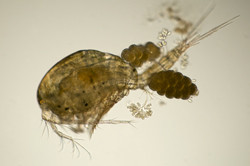Plankton and climate change models
Open ocean (pelagic) ecosystems play a crucial role in modifying the global environment due to their regulatory effects on the Earth's climate and their role in biogeochemical cycling. Concern has been expressed about the effects of environmental change on pelagic communities, such as alterations in biodiversity or community composition. Scientists from the BIODIV-LOG (A global approach towards linking climate and marine biodiversity to ecosystem functioning) project investigated geographic variation in copepod species diversity and body size at a global scale, and its effect on carbon export. These patterns in global diversity were integrated across different levels of the food chain, from phytoplankton to fish. Researchers also evaluated the effect of a changing climate and environment on global marine diversity and the carbon cycle. In addition, they forecast potential shifts in the distribution of pelagic biodiversity under different climate change scenarios. The results were used to predict future changes in the functioning of ecosystems and the benefits they provide. The project tested 74 ecologically realistic scenarios. They were then compared with observed patterns of biodiversity for foraminifers (a single-celled organism) and copepods, both important forms of pelagic plankton. Results revealed the significant effect of temperature on biodiversity at the global scale. A study was carried out on copepod size variation and distribution along latitudinal gradients, associated with temperature and other physical factors. It was discovered that copepods show a strong geographic variation in body size within the same species. However, although large individuals are found everywhere, small individuals mainly occur in lower latitudes and transition zones. Variation in body size within species was found to follow environmental gradients, such as seasonal variability in primary production. This result agreed with earlier studies where environmental temperature was shown to affect the body size of copepods. The high level of copepod body size variability within species on a global scale demonstrates the need to consider temperature regime and body size in models. BIODIV-LOG will enable relationships to be assessed between pelagic biodiversity, mean community size structure and the functioning of the ecosystem at global scale. This information can be used to understand how the impacts of climate change on plankton will affect global carbon cycling, thereby providing vital data for models of global climate change.
Keywords
Plankton, climate change, biodiversity, marine biodiversity, ecosystem functioning

